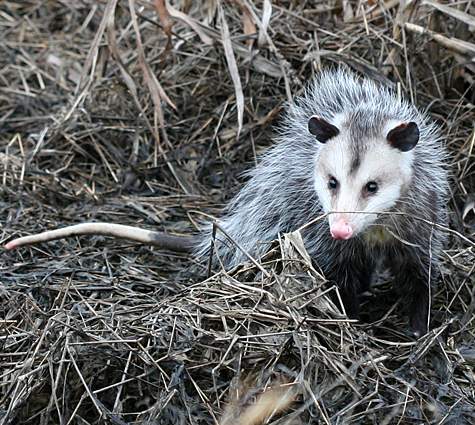
Virginia opossum, or North American opossum(Didelphis virginiana)
Phylum —chordata
Class — mammalia
Order — didelphimorphia
Family — didelphidae
Genus—didelphis
Appearance
Virginia opossums are robust marsupials, with short legs and thick bodies. Their pelage is typically grayish, but it may range from a reddish, brownish or even blackish hue. Within their fur, this species has long white tipped guard hairs. Their coloration may vary based on the range of the population; for instance, northern populations tend to have lighter guard hairs, thicker under fur and a more grizzled appearance, whereas southern populations generally appear darker and have thinner under fur. The fur of their face tends to be lighter than the rest of their body; it is typically pale grayish-white. They have large delicate ears, which are predominately furless, making frost bite to that region extremely common. Likewise, their long tails are also common victims of frost bite. Although there is fur at the base of their tail, it is largely hairless throughout. Virginia opossums’ tails are very long; they tend to be about 93% as long as their head to body length.
Males often weigh between 2.1 to 2.8 kg, whereas females generally range between 1.9 to 2.1 kg. Males have an average body length of 40.8 cm, with a tail length of 29.4 cm, whereas female body lengths average 40.6 cm, with a tail length of 28.1 cm.
Habitat
Virginia opossums live in most parts of the United States that are east of the Rocky Mountains, and along the west coast from British Columbia in Canada and to Baja California. It is also found in Mexico and Central America.
Behavior
Virginia opossums are nocturnal, solitary and terrestrial. They are very good climbers and may establish their dens in trees. They begin their nightly activities at dusk and are active until dawn. They don’t hibernate but do reduce activity during the coldest seasons. Denning sites vary and may include buildings, abandoned burrows and hollow trees. Virginia opossums change their denning sites often. They only remain in one den for a long period when weaning young.
Diet
Virginia opossums are omnivorous and will eat almost anything, including many different plants such as fruits, and small animals and insects. Sometimes they will eat garbage and carrion.
Reproduction
These opossums are polygynous, which means that one male mates with multiple females. Breeding is typically from December to August. The brief gestation period is 12 to 13 days and up to 25 young may be produced in each litter. However, the total number that can be raised is determined by how many teats (normally 13) are in the pouch. The average number of young is typically 7 or 8. On entering the pouch, each baby must find a nipple and attach itself or it will die. The pouch young remain firmly attached to a nipple for their first 50 to 55 days. Around 85 days old they begin eating solid food and are weaned completely between 93 and 105 days. They reach sexual maturity within their first year of life, at about 6 months for females and 8 for males.
Virginia opossums have a fairly short lifespan; wild individuals typically only survive about 1.5 to 2 years
In captivity
Opossums are easily tamed for a captivity and become completely whimsical. They like to sit on their keepers‘hands and heads. It is an instinct kept from childhood, when they traveled on their mother's back.
In the process of education, opossums should not be punished. Any severe punishment can lead to aggression. Also, aggression can be shown when the opossum is constantly kept in the cage. The opossum must have daily contact with a human if you want it to be tamed.
Opossums are excellent climbers and they do not have any difficulty in climbing up a tree, or on a wardrobe. Therefore, the apartment will need to organize special devices so that the animal can climb them.
It is no more difficult to train opossums to go to a toilet than to train a cat or a ferret. Put the tray next to their sleeping place, as well as in those rooms where you walk the animal.
Opossums do not require frequent bathing. A healthy opossum has no smell. Opossums are quite clean animals and take care of their skins.
The animal should be placed away from heating means (battery, microwave), be protected from drafts, as well as from direct sunlight.
The lifespan of opossums depends directly on their nutrition. Opossums will not live long if you feed them only factory-produced feed. The opossum's diet should consist of natural fresh or frozen foods, but in no case of ready-made feed. Also, the opossum cannot be fed beef and pork. In captivity, the animal is given chicken meat, boiled eggs, cottage cheese, fruit (mainly apples). Fruit can be given 2-3 times a week. Also, the menu of the animal should consist fish, mealworms, grasshoppers, cheese, yogurt and other dairy products, vegetable oil, nuts. Sometimes opossums are allergic to nuts. But this is rare.
The cage should be cleaned as often as possible (at least once a week). Opossums need constant access to water.
The opossum is a nocturnal animal, and they sleep during the day. However, domestic opossums often adapt to the rhythm of their owner's life. Also, opossums have a low body temperature - and because of this, they do not have fleas.
 Russian
Russian
 English
English























